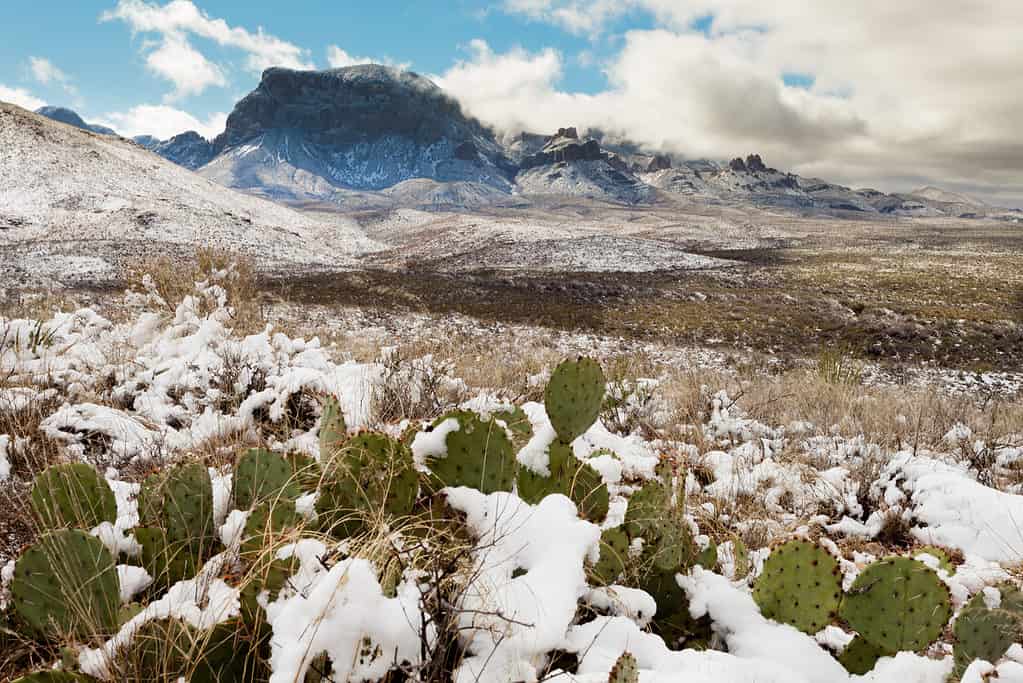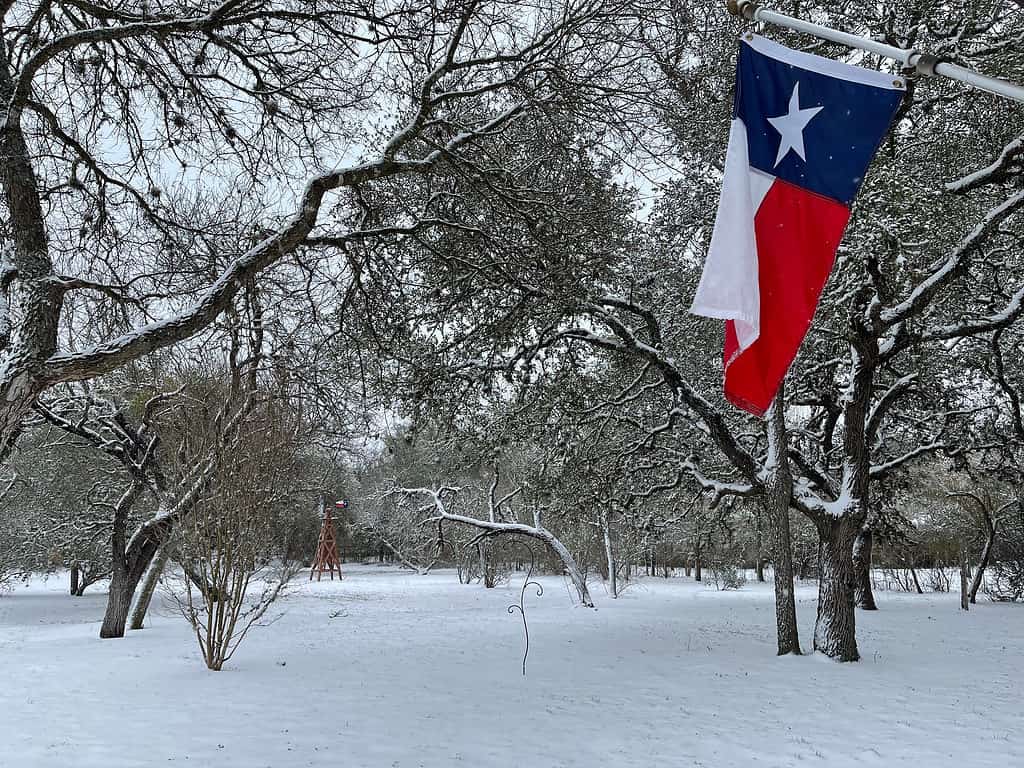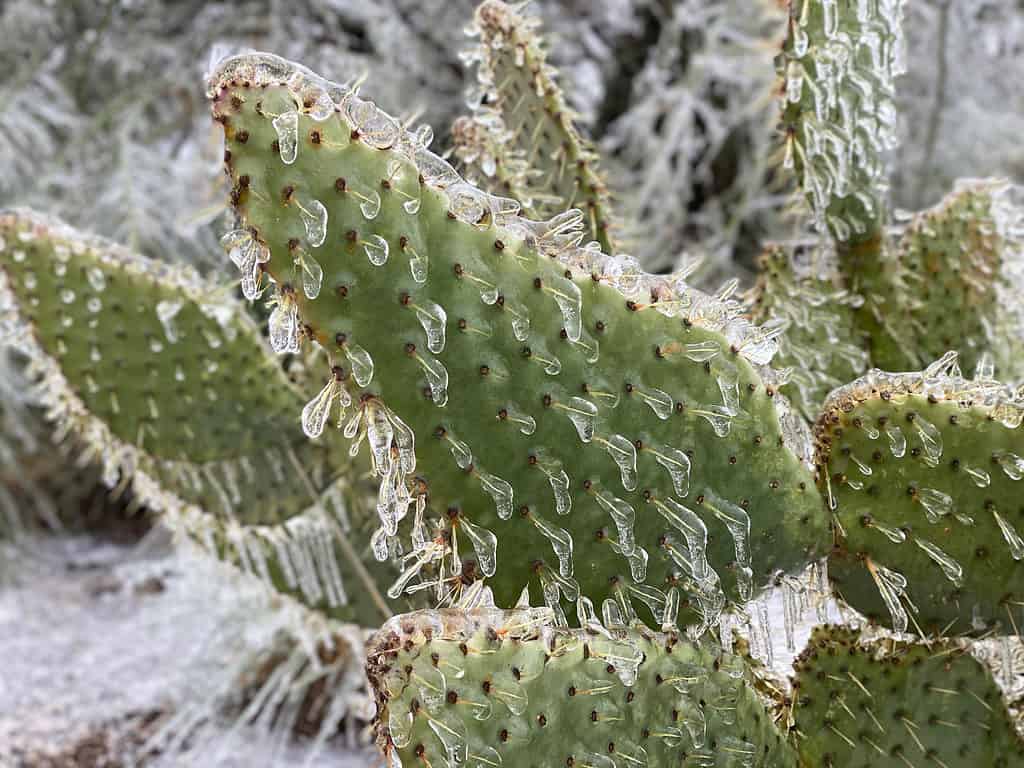Texas is not known as a cold state, at least not until the last few years. Instead, Texas is a warm state that experiences highs above 100 degrees Fahrenheit during the summer. However, Texas is a large state! It’s the largest state in the continental U.S. with unique environments. Not only are there mountains and deserts in Texas, but also grassy green plains and wet swamps. But did you know Texas has reached negative degrees before? Keep reading to learn more about the coldest temperature ever recorded in Texas.

©Pi-Lens/Shutterstock.com
Climate and Weather in Texas
Texas has a surface area of 268,596 square miles, so its no surprise there are different environments. In fact, it takes about 14 to 16 hours to cross Texas. The climate of Texas depends on the location. For example, it is mainly dry and arid in the west and humid in the east. The regions are divided as Northern Plains, Texas Hill Country, Trans-Pecos Region, Piney Woods, and South Texas.
The Northern Plains
The northern area of Texas is mainly semi-arid. The area is prone to drought but does receive rain. During winter nights in northern Texas, the temperature can drop below freezing. Tornadoes are also common since the region is part of Tornado valley. It’s more common for tornados to form in April and May. Northern Texas also experiences dust storms.
Texas Hill Country
The Texas Hill Country is part of central Texas and includes major cities like Austin, San Antonio, and Waco. It’s known for its many rivers and hills. The climate varies but is sub-humid east and south of Brady through Junction to Rocksprings. Towards the west, the climate is semi-arid. There are also many different types of plants in this region which especially grow near the wet rivers.
The Trans-Pecos Region
The Trans-Pecos region is in the western part of Texas and includes the Chihuahuan Desert. This area mainly sees clear skies with little rain or snow. Although the climate is arid, in the mountain ranges, you can find coniferous forests.
Piney Woods
Piney Woods is the eastern part of Texas. The climate of the area is humid and subtropical. This region receives the most rainfall in all of Texas. Severe thunderstorms and tornadoes are common in this area. Not only are thunderstorms common, but hurricanes do hit Piney Woods. Summers in this region feel very hot because of the high humidity.
South Texas
South Texas is unique as it has the semiarid ranch country and the wetter Rio Grande Valley. This is the southernmost tip of the American Great Plains region. South Texas is warm, with April, May, and September being the wettest months. This region also sees a lot of rainfall and is at risk for hurricanes and other severe storms. Tornadoes can happen, but it’s not as common as in other parts of Texas.

©Lea Bouknight/Shutterstock.com
Snowfall and Rainfall in Texas
The average rainfall in Texas is 27.25 inches per year. However, some regions of Texas receive more rain than others. For example, the far east Piney Woods area receives about 60 inches of rain annually, while the Trans Pecos Region receives less than 16 inches. Interestingly, even though the Northern Plains region is prone to drought, it still receives about 16 to 32 inches of precipitation annually.
Snow is even less common than rainfall. However, more snow has started to fall in Texas in the last few years. The average snowfall in Texas is 0.1 inches, but northern Texas receives about 15 to 30 inches of snow every year. The highest snowfall in Texas occurs in the panhandle near New Mexico. Texas received the most snowfall in February 1956 during a snowstorm. The highest record was 61 inches at Vega. In one day, Plainview, Texas, received 24 inches during the same storm.
The Coldest Temperature Ever Recorded in Texas
On February 12, 1899, the lowest temperature ever recorded in Texas was -23 degrees Fahrenheit. It was first recorded in Tulia, a Texas city in the Texas panhandle. While that’s an official reading, unofficial records at Wolf Creek measured lows at below 30. Three decades later on February 8, 1933, Seminole, a city in west Texas also experienced -23 degrees. No other cities in Texas have come close. However, Lubbock in 1933, did drop below 17.

©Meyta/Shutterstock.com
Texas Animals that thrive During Winter
Winter in Texas looks different everywhere you go. However, in Texas regions where temperatures drop and snow if possible, animals grow thicker coats and find warm places to rest. For example, white-tailed deer grow heavy winter coats to survive harsh winters. Bats either migrate to where there is a steady supply of insects or hibernate in a safe cave or culvert. Not all birds migrate south for the winter. Some bird species stay in Texas, but “fluff up” their feathers to keep warm. The ones that stay in cold regions of Texas rely on their fat storage. If you want to help birds survive winter, set up bird baths and bird feeders, since it’s hard for birds to find reliable food sources in the cold.

©iStock.com/Matt Dirksen
Up Next
- Discover Texas’s Coldest January on Record
- The Coldest Temperature Ever Recorded in Tennessee Is Devastatingly Cold
- Discover the Coldest Place in Tennessee
- Discover Alaska’s Coldest January on Record
The post Discover the Coldest Temperature Ever Recorded in Texas appeared first on AZ Animals.
from Animal News, Facts, Rankings, and More! - AZ Animals https://ift.tt/971R0rc